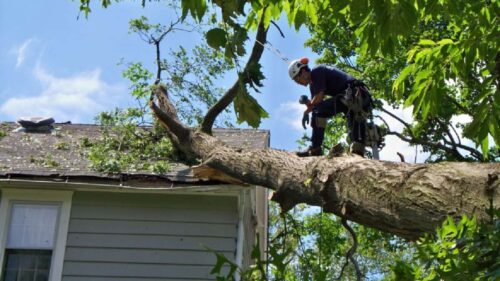Trees are a great way to elevate the aesthetic and overall value of your property. However, after a bad storm, contracting disease or dying, your trees can quickly become hazardous and pose a risk to your property and other people.
We at Jim’s Trees are experts when it comes to handling hazardous trees and know when a tree should be removed and how to do it. We explain when you should be aware that your tree is dangerous and how to best get it removed.
When is a tree considered dangerous?
A tree is usually considered dangerous or a hazard once it has died, unhealthy, or has signs of decay. Common signs that your tree is dangerous include broken or dead branches, deep cracks or splitting of bark, and decaying areas on the trunk, roots or canopy. A tree may also be deemed hazardous if it is too tall, leaning to one side, or has disruptive roots. If you think your tree is at risk of becoming hazardous, you should have a professional arborist report done. Otherwise, you may run the risk of removing a protected tree or a perfectly healthy tree.
Which mulch you use on your trees will depend upon your tree’s needs. If you are wanting to prevent pests or weeds thriving in your soil and improve the aesthetics of your landscape, it’s best to use inorganic mulch. However, if you are wanting to retain moisture, add vital nutrients to the soil and aid in growth, it’s best to use organic mulch. This mulch also has the benefit of breaking down into the soil over time.
Why do you need to remove a tree?
Aside from improving the aesthetics of your property, removing a dangerous tree is important for safety reasons. A dying or dead tree can fall easily which can result in damaging property, vehicles, powerlines or even run the risk of causing a fatal accident. Fallen branches may also fall quickly and unexpectedly, which can also create road and footpath obstructions as well as unwanted damage to your property.
You may also find that failing to remove a dangerous tree can create additional problems with your existing tree and garden as a dead tree can easily spread disease, divert important water resources and nutrients from other plants, and attract pests.
Hazardous roots can also cause a range of problems, from disrupting essential underground pipes to cracking the foundations of your home. Removing these after the damage has occurred can be costly and difficult, so it’s recommended that you tackle this problem as soon as possible. If your tree is growing too close to your neighbour’s property, you could potentially be liable for any damages to their property caused by your tree. It can also create tension with disgruntled neighbours which is always best avoided.
When should you remove a tree?
As mentioned earlier in the article, before you decide to remove a dangerous tree you need to receive an assessment from a professional arborist. Some trees may only require pruning services to remove the hazardous or dead branches, and continue growing. However, others may need the full tree and stump removal to ensure the safety of your property. Ideally, you should remove a tree as soon as it is considered dangerous or a potential hazard.
Should you remove a dangerous tree yourself?
If you have a dangerous tree on your property, you may consider getting out the chainsaw and taking a crack at removing the tree yourself. Before you decide to remove the tree, it’s important to be aware of the dangers of D-I-Y tree removal. Not only do you run the risk of doing a bad job, you can potentially damage your property or injure yourself. Dying or dead trees can be unpredictable and unstable so attempting to remove the tree without the right training and equipment can be highly dangerous.
Instead, it’s best to call the experts! By using a professional tree removal service, you can trust that your tree will be removed safely and according to proper removal procedure. The experts will ensure that your tree is completely removed (including the stump) without causing any damage to your property or surrounding trees. They will also remove any remaining green waste which can be repurposed into mulch or wood chips to use on your garden and trees.
Learn more about tree removal
You can learn more about removing a dangerous tree and why professional tree removal is important by checking out our expert tree removal services page or by getting in touch with our friendly team! We can advise on your specific tree situation and determine the best course of action forward.

